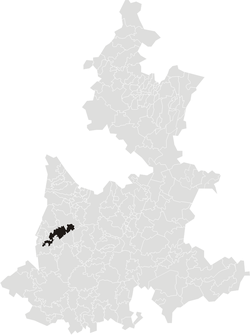Huaquechula
| Huaquechila | ||
|---|---|---|
| City | ||
| Huaquechula | ||

Location of municipality
|
||
|
||
| Coordinates: 18°46′00″N 98°33′00″W / 18.76667°N 98.55000°WCoordinates: 18°46′00″N 98°33′00″W / 18.76667°N 98.55000°W | ||
| Country |
|
|
| State | Puebla | |
| Founded | 1110 (official) | |
| Municipal Status | 1895 | |
| Government | ||
| • Municipal President | Raúl Marín Espinoza | |
| Population (2005)Municipality | ||
| • Municipality | 26,114 | |
| Time zone | CST (UTC-6) | |
| Website | [1] | |
Huaquechula is a town in Huaquechula Municipality located in state of Puebla in central Mexico. The settlement dates back at least as far as 1110 CE although its center has moved to twice to its current location. Since its founding, it has been an agricultural community, today raising crops such as peanuts, corn and sorghum, although there are some handcrafts as well. The town is known for its traditions related to the Feast of the Cross, but even more so for its “cabo del año” altars on Day of the Dead, which are dedicated to family members who have died during the previous year. These have been declared a cultural heritage of the state of Puebla and bring tourists to the town, mostly from Puebla.
The town of Huaquechula is about sixty km from the state capital, in the western part of the state. It is centered on a main plaza, which has pieces representing the area’s past such as a calendar stone, fragments of a stone head of Quetzalcoatl and tombstone with the date written in according to the Aztec calendar. The plaza’s fountain is made of black sandstone. Facing this plaza are the municipal “palace” a parish church, a cultural center called Cuauhquechollan and a former monastery from the 16th century.
The monastery was begun in 1531 and was finished in 1580, built by the Franciscan order, with attribution to Juan de Alameda, whose remains are buried there. It is similar to the monastery in Huejotzingo, though it lacks that building’s pre-Hispanic symbolism. The facade is Plateresque with a richly adorned main portal in sandstone. The open chapel is Gothic. The main altarpiece in the monastery is also Plateresque and dates from the 17th century and is over ten meters high and five meters wide. The former cloister area is now a local museum. The walls still contains remnants of the monastery’s rich mural work, and the rooms contains archeological pieces, copies of various codices and a section dedicated to Day of the Dead. In front, there is a stone cross over an image of the world and images of the sun and moon.
The town also has other reminders of its long history. The Piedra Máscara (Stone Mask) monument is located on the old road to San Juan Vallarta. It represents the old gods of the pre Hispanic population. The Piedra del Sol y la Luna (Stone of the Sun and Moon) is located on the old road to Xonaca, and depicts a lunar eclipse. The Piedra del Coyote (Coyote Stone) is near the river that leads to Xonaca. It represents the death of a coyote. A cross was later erected over this stone.
...
Wikipedia

